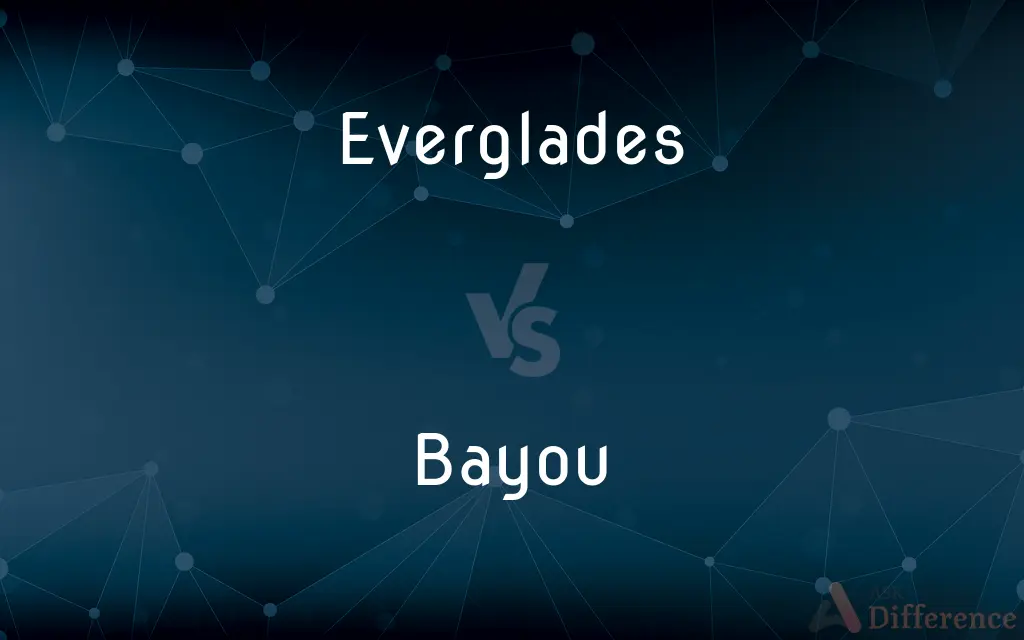Everglades vs. Bayou — What's the Difference?
Edited by Tayyaba Rehman — By Urooj Arif — Updated on March 10, 2024
The Everglades refers to a vast, tropical wetland in Florida known for its unique ecosystem, while a bayou is a slow-moving stream or a marshy outlet of a lake or river, commonly found in the Gulf Coast region of the United States.

Difference Between Everglades and Bayou
Table of Contents
ADVERTISEMENT
Key Differences
The Everglades is a distinctive region characterized by its extensive freshwater marshes, mangrove forests, and diverse wildlife, including alligators, panthers, and a variety of bird species. It covers a significant portion of southern Florida and plays a crucial role in the region's water purification and flood control systems. A bayou, on the other hand, typically refers to a body of water found in flat, low-lying areas, particularly in the southeastern United States.
The ecosystem of the Everglades is unique due to its combination of both temperate and tropical plant communities. Bayous are often associated with the Mississippi River Delta region and are characterized by their slow-moving, stagnant waters. These waters can be either fresh or saltwater and are often surrounded by wetlands, such as swamps and marshes, supporting a rich biodiversity, including various species of fish, birds, and reptiles.
While the Everglades is a specific geographical location known for its extensive wetland ecosystem, the term "bayou" describes a type of water body that can be found in various locations, especially in the southeastern United States. The Everglades could contain bayous within its vast area, but not all bayous are part of the Everglades.
The management and conservation challenges facing these environments also differ. The Everglades faces issues related to water management, invasive species, and the impact of agriculture and urbanization. Conservation efforts focus on restoring natural water flow and protecting its unique biodiversity. Bayous, while also facing challenges from pollution, urban development, and climate change, require localized conservation efforts to maintain their ecological function and protect wildlife habitats.
Despite their differences, both the Everglades and bayous are vital to their regions' ecological health, providing essential habitats for a wide range of species and offering natural flood protection. Their preservation and restoration are crucial for maintaining biodiversity, supporting fisheries, and protecting against the impacts of climate change.
ADVERTISEMENT
Comparison Chart
Location
Southern Florida, USA
Gulf Coast region, particularly around the Mississippi River Delta, USA
Ecosystem
Tropical wetland with freshwater marshes, mangrove forests
Slow-moving or stagnant water bodies, often surrounded by wetlands
Biodiversity
Alligators, panthers, diverse bird species
Fish, birds, reptiles, and other wetland species
Environmental Significance
Water purification, flood control, unique biodiversity
Biodiversity hotspots, natural flood protection
Conservation Challenges
Water management, invasive species, urbanization
Pollution, urban development, climate change
Compare with Definitions
Everglades
Conservation Area.
The Everglades National Park was established to protect this unique environment.
Bayou
Conservation Efforts.
Efforts to conserve bayous focus on combating pollution and protecting habitats.
Everglades
Water Resource.
The Everglades plays a crucial role in South Florida's water purification and flood control systems.
Bayou
Water Body.
Bayous, often found in the Gulf Coast region, are characterized by their slow-moving waters.
Everglades
Biodiversity Haven.
The diverse habitats within the Everglades support an array of wildlife, including endangered species.
Bayou
Fishing Grounds.
Many bayous are vital for local fisheries, providing habitat for various fish species.
Everglades
Unique Ecosystem.
The Everglades is home to both temperate and tropical species, making it a unique ecosystem.
Bayou
Wetland Ecosystem.
Surrounded by marshes and swamps, bayous support a rich biodiversity.
Everglades
Vast Wetland.
Covering a significant area of Florida, the Everglades is one of the largest wetlands in the world.
Bayou
Cultural Significance.
Bayous hold cultural importance in the Gulf Coast region, featuring prominently in local lore and lifestyle.
Everglades
The Everglades is a natural region of tropical wetlands in the southern portion of the U.S. state of Florida, comprising the southern half of a large drainage basin within the Neotropical realm. The ecosystem it forms is not presently found anywhere else on earth.
Bayou
In usage in the Southern United States, a bayou () is a body of water typically found in a flat, low-lying area, and may refer to an extremely slow-moving stream or river (often with a poorly defined shoreline), a marshy lake or wetland or a creek whose current reverses daily due to tides, and which contains brackish water highly conducive to fish life and plankton. Bayous are commonly found in the Gulf Coast region of the southern United States, especially in the Mississippi River Delta.
Everglades
Plural of everglade
Bayou
A body of water, such as a creek or small river, that is a tributary of a larger body of water.
Everglades
A large subtropical swamp in southern Florida that is noted for its wildlife
Bayou
A sluggish stream that meanders through lowlands, marshes, or plantation grounds.
Bayou
A slow-moving, often stagnant creek or river.
Bayou
A swamp; a marshy (stagnant) body of water.
Bayou
An inlet from the Gulf of Mexico, from a lake, or from a large river, sometimes sluggish, sometimes without perceptible movement except from tide and wind.
A dark slender thread of a bayou moves loiteringly northeastward into a swamp of huge cypresses.
Bayou
A swampy arm or slow-moving outlet of a lake (term used mainly in Mississippi and Louisiana)
Common Curiosities
What makes the Everglades unique?
The Everglades' unique combination of temperate and tropical ecosystems, vast wetlands, and diverse wildlife sets it apart.
How do the Everglades and bayous differ?
The Everglades is a specific tropical wetland area in Florida, while a bayou is a type of water body found in various locations, especially in the Gulf Coast region.
Why are the Everglades important?
The Everglades are crucial for water purification, flood control, and supporting unique biodiversity in southern Florida.
How does climate change affect the Everglades and bayous?
Climate change threatens both environments with rising sea levels, altered water patterns, and increased vulnerability to invasive species.
What is a bayou?
A bayou is a slow-moving or stagnant water body, often found in low-lying, flat areas, surrounded by wetlands.
What challenges do bayous face?
Bayous face environmental challenges such as pollution, urban development, and the impacts of climate change.
Can the Everglades contain bayous?
Yes, the vast wetland ecosystem of the Everglades could include bayous as part of its diverse aquatic environments.
What role do bayous play in the environment?
Bayous contribute to regional biodiversity, serve as natural flood protection, and support local fisheries and ecosystems.
How are conservation efforts different for the Everglades and bayous?
The Everglades' conservation focuses on restoring natural water flow and combating invasive species, while bayou conservation efforts are more localized, addressing pollution and habitat protection.
What is being done to protect these ecosystems?
Conservation efforts include restoring natural water flows, protecting wildlife habitats, combating invasive species, and raising public awareness to preserve these vital ecosystems.
Share Your Discovery

Previous Comparison
Outlook vs. Forecast
Next Comparison
Trustee vs. AdministratorAuthor Spotlight
Written by
Urooj ArifUrooj is a skilled content writer at Ask Difference, known for her exceptional ability to simplify complex topics into engaging and informative content. With a passion for research and a flair for clear, concise writing, she consistently delivers articles that resonate with our diverse audience.
Edited by
Tayyaba RehmanTayyaba Rehman is a distinguished writer, currently serving as a primary contributor to askdifference.com. As a researcher in semantics and etymology, Tayyaba's passion for the complexity of languages and their distinctions has found a perfect home on the platform. Tayyaba delves into the intricacies of language, distinguishing between commonly confused words and phrases, thereby providing clarity for readers worldwide.














































